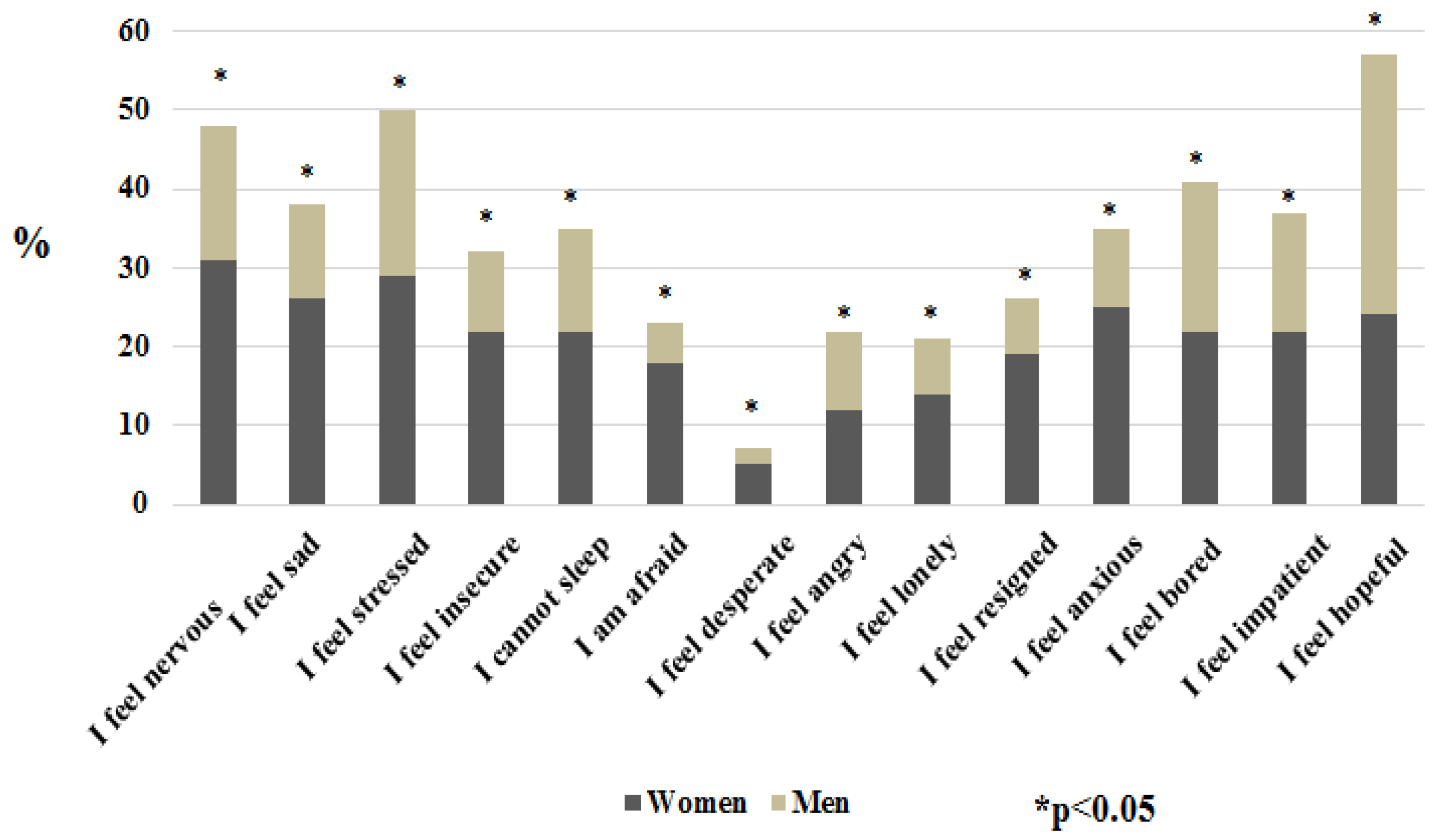Increased COVID-19 Lockdown Burden in Italian Adults with Gastrointestinal Diseases
Abstract
1. Introduction
2. Materials and Methods
Statistical Analysis
3. Results
3.1. Demographics
3.2. Physical Exercise during the Lockdown
3.3. Weight Gain and Food Choices
3.4. Emotional Impact
4. Discussion
Supplementary Materials
Author Contributions
Funding
Institutional Review Board Statement
Informed Consent Statement
Conflicts of Interest
References
- Wang, C.; Horby, P.W.; Hayden, F.G.; Gao, G.F. A novel coronavirus outbreak of global health concern. Lancet 2020, 395, 470–473. [Google Scholar] [CrossRef]
- Moccia, L.; Janiri, D.; Pepe, M.; Dattoli, L.; Molinaro, M.; De Martin, V.; Chieffo, D.; Janiri, L.; Fiorillo, A.; Sani, G.; et al. Affective temperament, attachment style, and the psychological impact of the COVID-19 outbreak: An early report on the Italian general population. Brain Behav. Immun. 2020, 87, 75–79. [Google Scholar] [CrossRef] [PubMed]
- ilsole24ore. Coronavirus, Corsa ai Supermercati. Ma non c’è il Rischio di Scaffali Vuoti. 2020. Available online: https://www.ilsole24ore.com/art/coronavirus-corsa-supermercati-ma-non-c-e-rischio-scaffali-vuoti-AC24keLB?refresh_ce=1 (accessed on 24 February 2020).
- Knoops, K.T.; de Groot, L.C.; Kromhout, D.; Perrin, A.E.; Moreiras-Varela, O.; Menotti, A.; Van Staveren, W.A. Mediterranean diet, lifestyle factors, and 10-year mortality in elderly European men and women: The HALE project. JAMA 2004, 292, 1433–1439. [Google Scholar] [CrossRef] [PubMed]
- Neira, C.; Godinho, R.; Rincón, F.; Mardones, R.; Pedroso, J. Consequences of the COVID-19 Syndemic for Nutritional Health: A Systematic Review. Nutrients 2021, 13, 1168. [Google Scholar] [CrossRef] [PubMed]
- Maugeri, G.; Castrogiovanni, P.; Battaglia, G.; Pippi, R.; D’Agata, V.; Palma, A.; Di Rosa, M.; Musumeci, G. The impact of physical activity on psychological health during Covid-19 pandemic in Italy. Heliyon 2020, 6, e04315. [Google Scholar] [CrossRef] [PubMed]
- Mõttus, R.; Realo, A.; Allik, J.; Deary, I.J.; Esko, T.; Metspalu, A. Personality traits and eating habits in a large sample of Estonians. Health Psychol. 2012, 31, 806–814. [Google Scholar] [CrossRef]
- Pfeiler, T.M.; Egloff, B. Personality and eating habits revisited: Associations between the big five, food choices, and Body Mass Index in a representative Australian sample. Appetite 2020, 149, 104607. [Google Scholar] [CrossRef] [PubMed]
- Chen, Q.; Zheng, Z.; Zhang, C.; Zhang, X.; Wu, H.; Wang, J.; Wang, S.; Zheng, C. Clinical characteristics of 145 patients with coronavirus disease 2019 (COVID-19) in Taizhou, Zhejiang, China. Infection 2020, 48, 543–551. [Google Scholar] [CrossRef] [PubMed]
- ISTAT-Istituto Nazionale di Statistica. SIQUAL—Information System on Quality of Statistical Production Processes. Multiscopo Sulle Famiglie: Aspetti Della Vita Quotidiana; ISTAT: Rome, Italy, 2020.
- Zhou, F.; Yu, T.; Du, R.; Fan, G.; Liu, Y.; Liu, Z.; Xiang, J.; Wang, Y.; Song, B.; Gu, X.; et al. Clinical course and risk factors for mortality of adult inpatients with COVID-19 in Wuhan, China: A retrospective cohort study. Lancet 2020, 395, 1054–1062. [Google Scholar] [CrossRef]
- Haidar, S.A.; de Vries, N.; Karavetian, M.; El-Rassi, R. Stress, Anxiety, and Weight Gain among University and College Students: A Systematic Review. J. Acad. Nutr. Diet. 2018, 118, 261–274. [Google Scholar] [CrossRef] [PubMed]
- Wang, C.; Pan, R.; Wan, X.; Tan, Y.; Xu, L.; Ho, C.S.; Ho, R.C. Immediate Psychological Responses and Associated Factors during the Initial Stage of the 2019 Coronavirus Disease (COVID-19) Epidemic among the General Population in China. Int. J. Environ. Res. Public Health 2020, 17, 1729. [Google Scholar] [CrossRef] [PubMed]
- Meng, Y.; Wu, P.; Lu, W.; Liu, K.; Ma, K.; Huang, L.; Cai, J.; Zhang, H.; Qin, Y.; Sun, H.; et al. Sex-specific clinical characteristics and prognosis of coronavirus disease-19 infection in Wuhan, China: A retrospective study of 168 severe patients. PLoS Pathog. 2020, 16, e1008520. [Google Scholar] [CrossRef]
- Geldsetzer, P. Use of Rapid Online Surveys to Assess People’s Perceptions During Infectious Disease Outbreaks: A Cross-sectional Survey on COVID-19. J. Med. Internet Res. 2020, 22, e18790. [Google Scholar] [CrossRef]
- Savarino, E.V.; Iovino, P.; Santonicola, A.; Ghisa, M.; Laserra, G.; Barberio, B.; Maniero, D.; Lorenzon, G.; Ciacci, C.; Savarino, V.; et al. Clinical and Psychological Impact of COVID-19 Infection in Adult Patients with Eosinophilic Gastrointestinal Disorders during the SARS-CoV-2 Outbreak. J. Clin. Med. 2020, 9, 2011. [Google Scholar] [CrossRef] [PubMed]
- Siniscalchi, M.; Zingone, F.; Savarino, E.V.; D’Odorico, A.; Ciacci, C. COVID-19 pandemic perception in adults with celiac disease: An impulse to implement the use of telemedicine: COVID-19 and CeD. Dig. Liver Dis. 2020, 52, 1071–1075. [Google Scholar] [CrossRef] [PubMed]
- Furnham, A. Response bias, social desirability and dissimulation. Pers. Individ. Differ. 1986, 7, 385–400. [Google Scholar] [CrossRef]
- Robinson, E.; Boyland, E.; Chisholm, A.; Harrold, J.; Maloney, N.G.; Marty, L.; Mead, B.R.; Noonan, R.; Hardman, C.A. Obesity, eating behavior and physical activity during COVID-19 lockdown: A study of UK adults. Appetite 2021, 156, 104853. [Google Scholar] [CrossRef] [PubMed]
- Shen, W.; Long, L.M.; Shih, C.-H.; Ludy, M.-J. A Humanities-Based Explanation for the Effects of Emotional Eating and Perceived Stress on Food Choice Motives during the COVID-19 Pandemic. Nutrients 2020, 12, 2712. [Google Scholar] [CrossRef] [PubMed]
- Marty, L.; de Lauzon-Guillain, B.; Labesse, M.; Nicklaus, S. Food choice motives and the nutritional quality of diet during the COVID-19 lockdown in France. Appetite 2021, 157, 105005. [Google Scholar] [CrossRef] [PubMed]
- Di Renzo, L.; Gualtieri, P.; Pivari, F.; Soldati, L.; Attinà, A.; Cinelli, G.; Leggeri, C.; Caparello, G.; Barrea, L.; Scerbo, F.; et al. Eating habits and lifestyle changes during COVID-19 lockdown: An Italiansurvey. J. Transl. Med. 2020, 18, 229. [Google Scholar] [CrossRef] [PubMed]


| Variables | Participants N = 1375 (100%) |
|---|---|
| Gender | |
| Women | 937 (68.2%) |
| Men | 438 (31.8%) |
| Age Groups, years (%) | |
| 18–29 | 169 (12.3%) |
| 30–49 | 669 (48.7%) |
| 50–69 | 490 (35.6%) |
| >70 | 47 (3.4%) |
| During the lockdown living with (%) | |
| Family | 1215 (88.4%) |
| alone | 17 (1.2%) |
| other | 143 (10.4%) |
| Region of residence (%) | |
| Red zone | 171 (12.4%) |
| Orange zone | 773 (56.2%) |
| Yellow zone | 431 (31.4%) |
| Type of work | |
| Unemployed | 118 (8.6%) |
| Students | 107 (7.8%) |
| Retired | 26 (1.9%) |
| Workers | 1124 (81.7%) |
| Are you regularly going to work? | |
| I regularly go to work | 237 (21.1%) |
| I go to work fewer days than before | 138 (12.3%) |
| I am in smart working at home | 433 (38.5%) |
| I am not going to work, nor do I work at home. | 316 (28.1%) |
| The house in which you are living has a: | |
| Garden | 435 (31.6%) |
| Balcony | 547 (39.8%) |
| Window | 115 (8.3%) |
| Common open space | 278 (20.3%) |
| Total N= 1375 (100%) | Women N = 937 | Men N = 438 | p * | |
|---|---|---|---|---|
| Dyslipidaemia | 15.7 | 14.3 | 18.5 | 0.05 |
| Cardiovascular | 13.8 | 10 | 22.1 | <0.001 |
| Liver | 0.5 | 0.2 | 1.1 | 0.02 |
| Functional GI disorders | 11.3 | 13.1 | 7.5 | 0.002 |
| Inflammatory bowel disease | 1.9 | 1.5 | 2.7 | 0.1 |
| Diabetes | 2.8 | 1.7 | 5.2 | <0.001 |
| Food intolerance/allergies | 1.4 | 1.8 | 0.7 | 0.1 |
| Mood disorders | 9.2 | 10.9 | 5.5 | 0.001 |
| Other | 12.6 | 15.1 | 7.3 | <0.001 |
| Female | Male | Participants: 1375 (100%) | p * | |
|---|---|---|---|---|
| Reporting weight gain | 492 (52.51%) | 222 (50.68%) | 714 (51.93%) | 0.52 |
| Age groups reporting weight gain | 0.73 | |||
| 18–29 | 54 (44.63%) | 28 (58.33%) | 82 (48.52%) | |
| 30–49 | 255 (52.04%) | 91 (50.84%) | 346 (51.72%) | |
| 50–69 | 172 (56.21%) | 90 (48.91%) | 262 (53.47%) | |
| >70 | 11 (55%) | 13 (48.15%) | 24 (51.06%) | |
| Reporting weight gain | 0.12 | |||
| Red zone | 55 (46.22%) | 22 (42.31%) | 77 (45.35%) | |
| Orange zone | 293 (55.39%) | 123 (50.41%) | 416 (53.82%) | |
| Yellow zone | 144 (49.83%) | 77 (54.23%) | 221 (51.50%) | |
| Average weight gain in kg | 0.045 | |||
| 1–2 | 351 (63.93%) | 156 (61.9%) | 507 (63.3%) | |
| 3–4 | 150 (27.32%) | 78 (30.95%) | 228 (28.46%) | |
| >4 | 48 (8.74%) | 18 (7.14%) | 66 (8.24%) |
| Foods | Never % F/M | Once a Week % F/M | 2–3 Times a Week % F/M | Every Day % F/M |
|---|---|---|---|---|
| Red meats | 11.9/6.1 | 51/52 | 37/41 | 0.1/0.9 |
| Poultry | 7/7 | 38/41 | 53/51 | 2/1 |
| Pork/preserved meat | 19/12 | 51/47 | 28/38 | 2/3 |
| Eggs | 5/4.8 | 63/66 | 30/27 | 1/2 |
| Fish | 9/9 | 49/52 | 38/37 | 4/2 |
| Dairy products | 28/32 | 20/21 | 29/26 | 23/21 |
| Cereals (wheat/other grains) | 3/3 | 9/8 | 32/30 | 56/59 |
| Vegetables | 1/1 | 3/7 | 25/46 | 71/46 |
| Beans | 10/6 | 47/44 | 41/48 | 2/2 |
| Fresh fruit | 6/5 | 6/7 | 23/26 | 65/62 |
| Dried fruits and nuts | 33/33 | 23/30 | 25/23 | 19/14 |
| Salty snacks | 7/8 | 58/48 | 30/38 | 5/6 |
| Sweets (candy bars, cakes, croissant, etc.) | 6/6 | 27/26 | 37/40 | 30/28 |
| Fruit juices | 83/72 | 7/15 | 7/8 | 3/5 |
| Sodas | 67/59 | 20/23 | 9/13 | 4/5 |
| Variable | ISTAT 2019 | Survey 2020 | p * |
|---|---|---|---|
| Red meat | 53 | 38 | 0.03 |
| Poultry | 79 | 53 | <0.001 |
| Pork/preserved meat | 60 | 31 | <0.001 |
| Eggs | 66 | 30 | <0.001 |
| Fish | 62 | 37 | <0.001 |
| Dairy products | 21 | 8 | 0.01 |
| Beans | 54 | 44 | 0.15 |
| Salty snacks | 28 | 32 | 0.53 |
| Sweets | 50 | 38 | 0.08 |
| Soft drinks | 61 | 36 | 0.000 |
| Wine | 56 | 53 | 0.886 |
| Beer | 54 | 47 | 0.322 |
| Spirits | 34 | 25 | 0.162 |
Publisher’s Note: MDPI stays neutral with regard to jurisdictional claims in published maps and institutional affiliations. |
© 2021 by the authors. Licensee MDPI, Basel, Switzerland. This article is an open access article distributed under the terms and conditions of the Creative Commons Attribution (CC BY) license (https://creativecommons.org/licenses/by/4.0/).
Share and Cite
Ruotolo, M.; Gagliardi, M.; Ciacci, C.; Zingone, F.; de Santis Ciacci, C.; Santonicola, A.; D'Arcangelo, G.; Siniscalchi, M. Increased COVID-19 Lockdown Burden in Italian Adults with Gastrointestinal Diseases. Nutrients 2021, 13, 1820. https://doi.org/10.3390/nu13061820
Ruotolo M, Gagliardi M, Ciacci C, Zingone F, de Santis Ciacci C, Santonicola A, D'Arcangelo G, Siniscalchi M. Increased COVID-19 Lockdown Burden in Italian Adults with Gastrointestinal Diseases. Nutrients. 2021; 13(6):1820. https://doi.org/10.3390/nu13061820
Chicago/Turabian StyleRuotolo, Monica, Mario Gagliardi, Carolina Ciacci, Fabiana Zingone, Corina de Santis Ciacci, Antonella Santonicola, Giovanna D'Arcangelo, and Monica Siniscalchi. 2021. "Increased COVID-19 Lockdown Burden in Italian Adults with Gastrointestinal Diseases" Nutrients 13, no. 6: 1820. https://doi.org/10.3390/nu13061820
APA StyleRuotolo, M., Gagliardi, M., Ciacci, C., Zingone, F., de Santis Ciacci, C., Santonicola, A., D'Arcangelo, G., & Siniscalchi, M. (2021). Increased COVID-19 Lockdown Burden in Italian Adults with Gastrointestinal Diseases. Nutrients, 13(6), 1820. https://doi.org/10.3390/nu13061820









